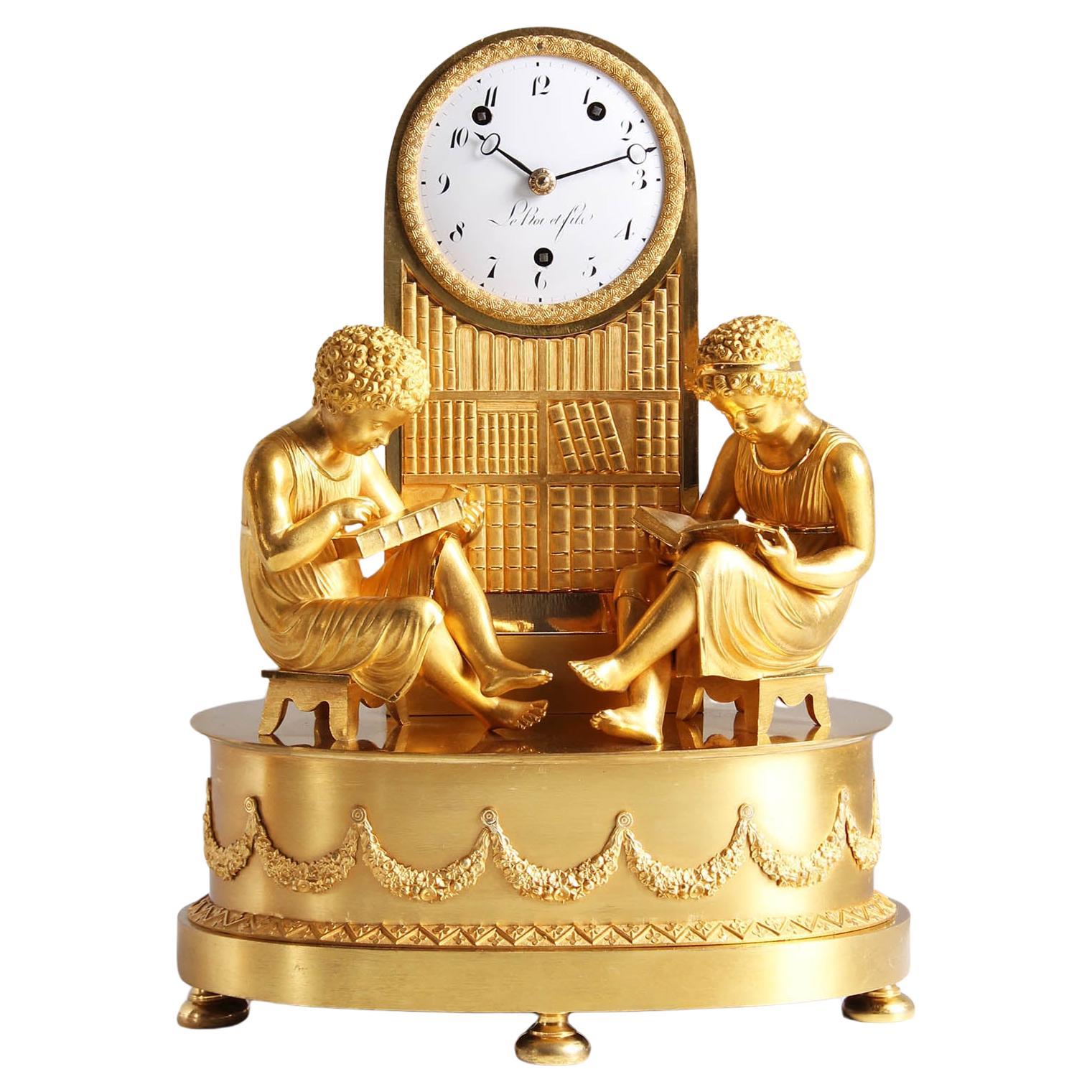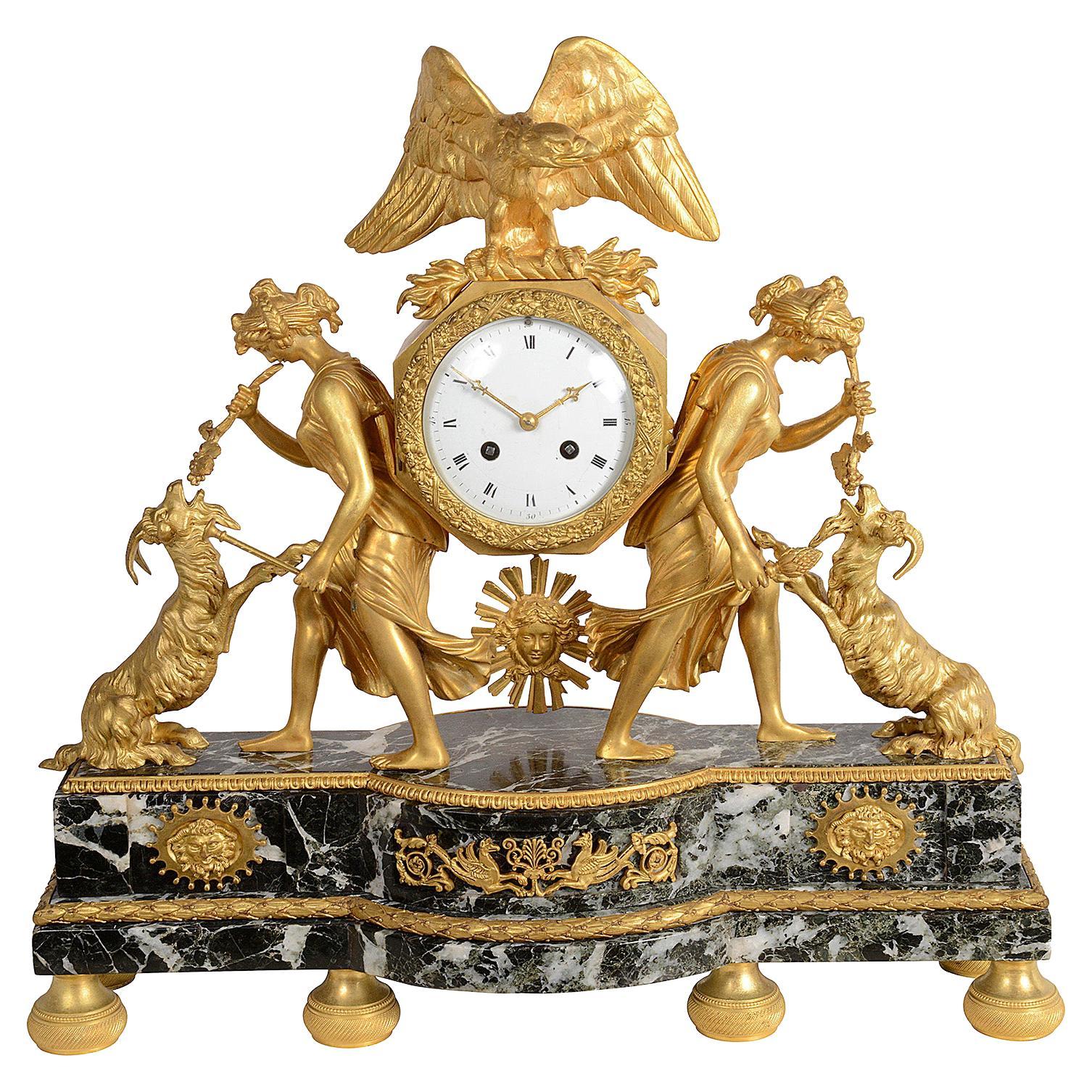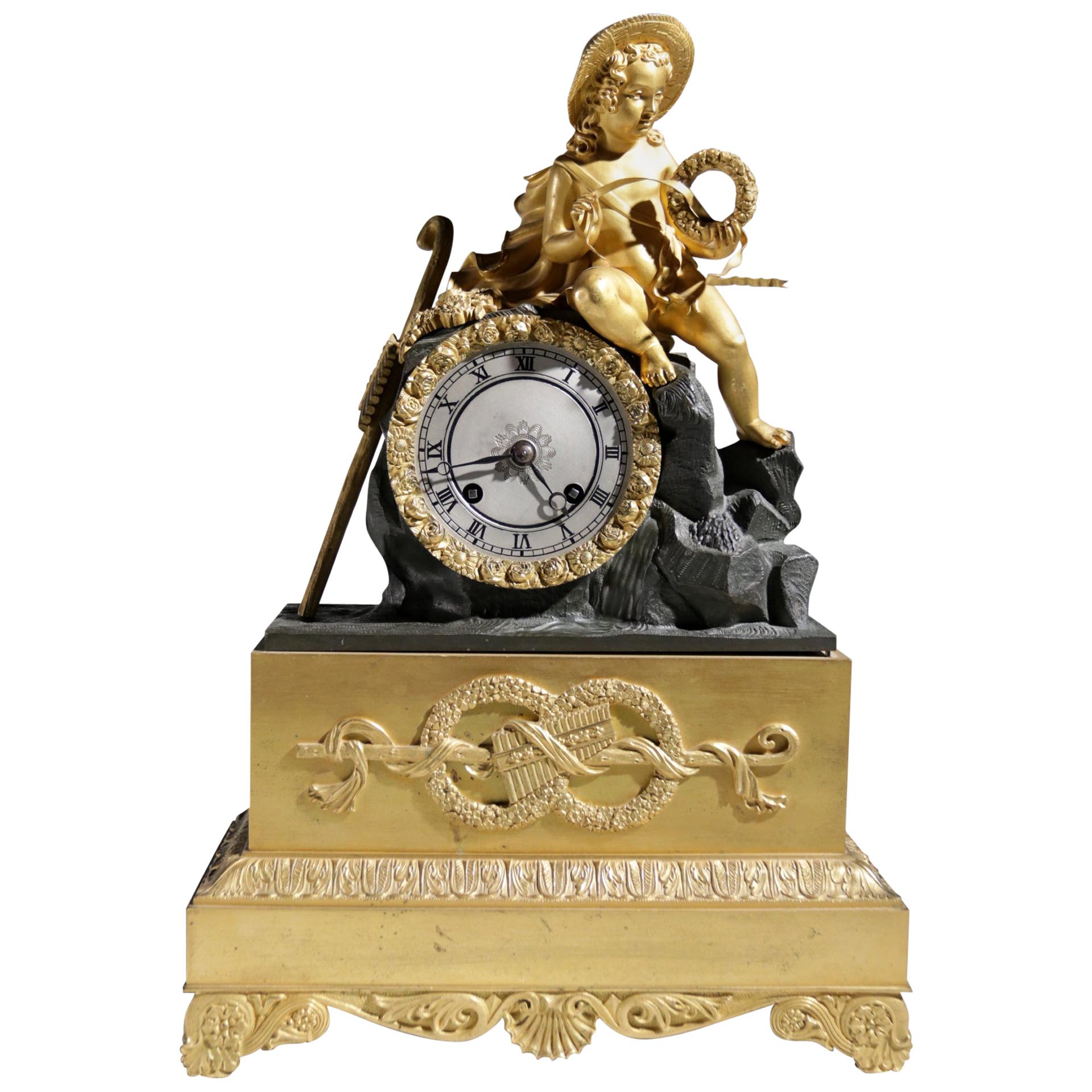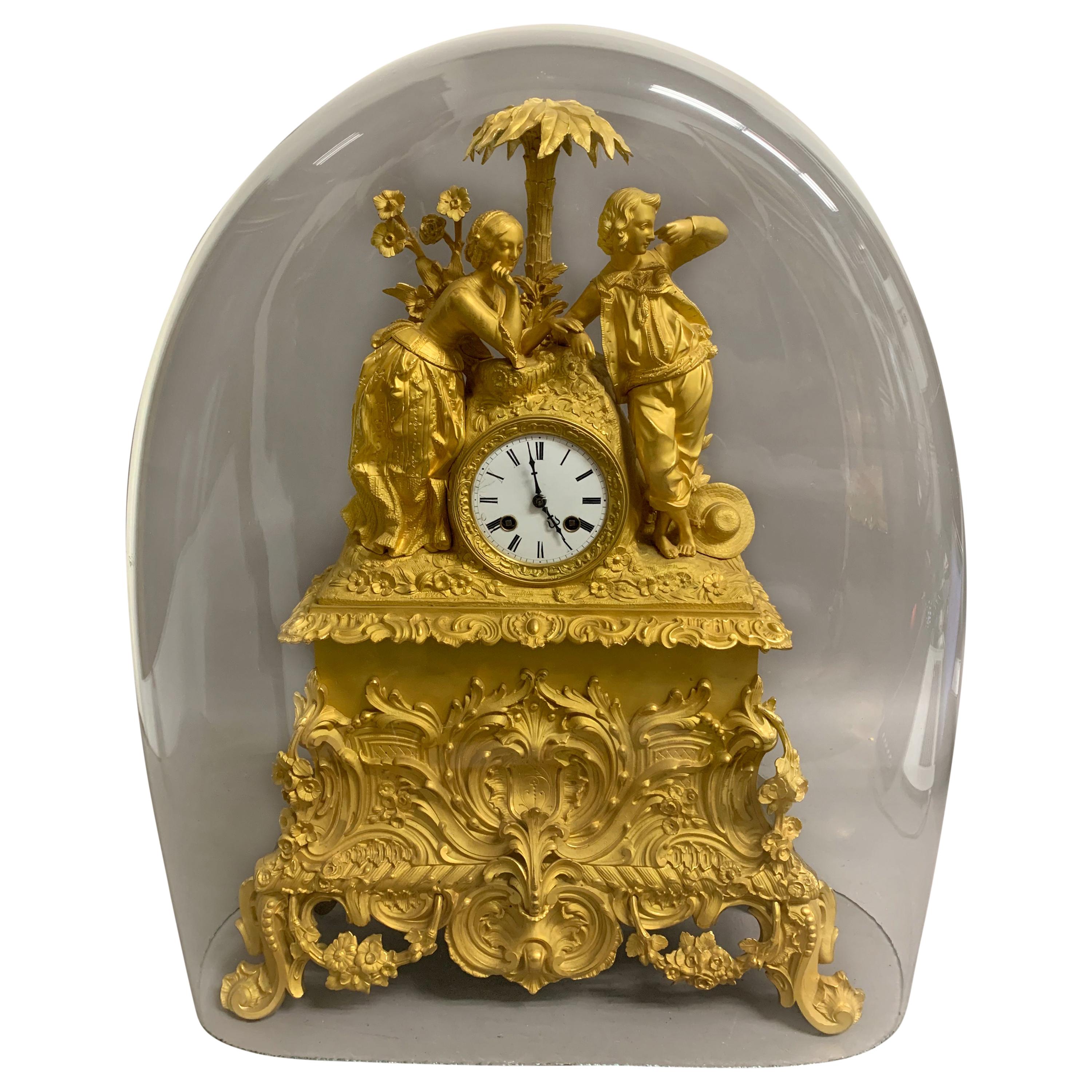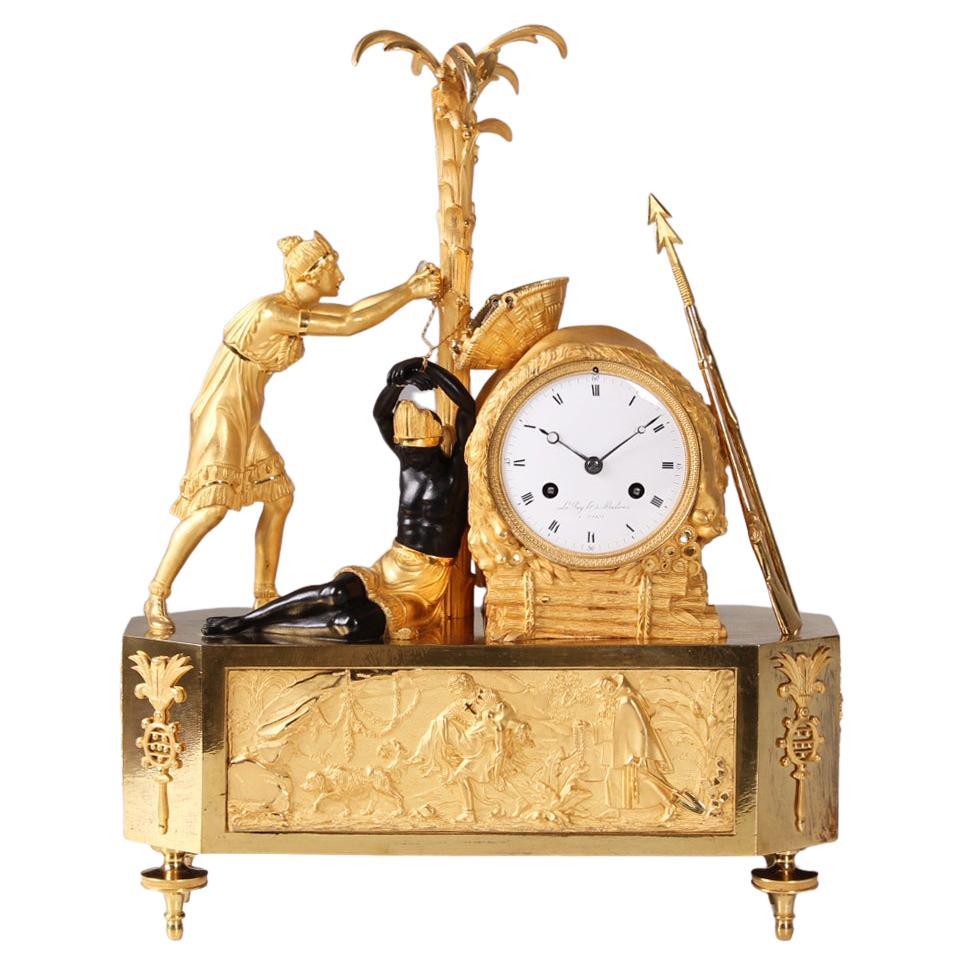Items Similar to Ormolu Mantel Clock, Belgium, circa 1810-1820
Want more images or videos?
Request additional images or videos from the seller
1 of 7
Ormolu Mantel Clock, Belgium, circa 1810-1820
About the Item
Empire ormolu mantel clock, Belgium, circa 1810, Signed "J.B. Romaet a Gand". Decorated with a shepherd scene. Strikes the hour and half hour on a bell. With enamel clock face and silk suspension. In very good working condition.
- Dimensions:Height: 14.18 in (36 cm)Width: 10.63 in (27 cm)Depth: 3.55 in (9 cm)
- Style:Empire (Of the Period)
- Materials and Techniques:
- Place of Origin:
- Period:
- Date of Manufacture:1810
- Condition:Wear consistent with age and use.
- Seller Location:Belmont, MA
- Reference Number:1stDibs: LU1772218797382
About the Seller
5.0
Gold Seller
These expertly vetted sellers are highly rated and consistently exceed customer expectations.
Established in 2013
1stDibs seller since 2015
233 sales on 1stDibs
Typical response time: 2 hours
- ShippingRetrieving quote...Ships From: Belmont, MA
- Return PolicyA return for this item may be initiated within 2 days of delivery.
More From This SellerView All
- Louis XVI Ormolu Mounted Black and White Marble Mantel Clock, Paris, 1800Located in Belmont, MALouis XVI ormolu-mounted black and white marble mantel clock, Paris, 1800. The white enamel dial with black Arabic numerals is contained ...Category
Antique 1790s French Louis XVI Mantel Clocks
MaterialsMarble, Ormolu
- 19th Century Louis XV Style Mantel ClockLocated in Belmont, MAUnique French 19th century mantel clock. This exquisite mantel clock has a Sevres porcelain dial plate and other Sevres porcelain decorations. The movement with spring suspension. ...Category
Antique 1890s French Louis XV Mantel Clocks
MaterialsOrmolu
- Empire Chest of Drawers, France 1810-1820, CherryLocated in Belmont, MAEmpire chest of drawers, France 1810-1820. This early 19th century elegant Empire chest of drawers has a cherry veneer and is decorated with original brass...Category
Antique 1810s French Empire Commodes and Chests of Drawers
MaterialsCherry
- French, Napoleon III Boulle Clock, 19th Century, S. Marti & CieBy Samuel MartiLocated in Belmont, MAFrench Napoleon III Boulle clock, Paris second half of 19th century. The clockwork was made by the famous company Samuel Martin & Cie, circa 1870-1890. (Makers Mark on the back). The cases beautifully designed with bronze details and Boulle technique inlays. A detailed sculpted bronze victory...Category
Antique 1880s French Napoleon III Mantel Clocks
MaterialsBronze
- Biedermeier Wardrobe, Baltic States, 1810-1820Located in Belmont, MABiedermeier Wardrobe, Baltic States 1810-1820, Bird’s-eye maple veneer, filament inserts on the doors and the pilaster strips. Inside one drawer and a coat rack. Two shelves have bee...Category
Antique 1810s Baltic Biedermeier Wardrobes and Armoires
MaterialsBirdseye Maple
- Neoclassical Commode, Germany 1810-1820, CherryLocated in Belmont, MANeoclassical commode, Germany 1810-1820. This elegant neoclassical commode is decorated with a beautiful cherry veneer. The two drawer commode stands on four pointed feet and has it...Category
Antique 1810s German Biedermeier Commodes and Chests of Drawers
MaterialsCherry
You May Also Like
- Empire Mantel Clock - La Bibliotheque, Ormolu, France, Paris, circa 1820By Le RoiLocated in Greven, DEMantel Clock - La Bibliotheque - In the study room Paris fire-gilt bronze, enamel Empire around 1820 Dimensions: H x W x D: 38 x 28 x 19 cm Description: Scenery mounted on an oval...Category
Antique Early 19th Century French Empire Mantel Clocks
MaterialsBronze
- French Empire Style Mantel Clock, circa 1820Located in Brighton, SussexA very impressive and stylish early 19th Century gilded ormolu and green marble mantle clock, having two classical maidens either side feeding Rams, an Eagle above the circular white...Category
Antique Early 19th Century French Empire Mantel Clocks
MaterialsMarble, Ormolu
- Empire Fire Gilded Mantel Clock, circa 1820Located in Boven Leeuwen, NLBeautiful fire gilded Empire mantel clock with a shepherdess on top with a wreath and ribbon. On the left a staff with pan flute. At the bottom of the clo...Category
Antique Early 19th Century French Empire Mantel Clocks
MaterialsBronze
- French Ormolu Figural Mantel Clock with Glass Dome, circa 1820Located in Los Angeles, CAA French Charles X period ormolu mantel clock. The drum case flanked by a young couple standing under a palm tree with flowers all around, while the lady touched the man's hand. The...Category
Antique 1820s French Charles X Mantel Clocks
MaterialsOrmolu
- Early 19th Century Ormolu Mantel Clock, Atala freeing Chactas, Paris, circa 1810Located in Greven, DEMantel Clock "Atala and Chactas" Paris Bronze (fire-gilt and patinated), enamel Empire around 1810 Dimensions: H x W x D: 40 x 32 x 11 cm Description: Very rare and extremely high quality French mantel clock, so-called Pendule Au Bon Sauvage. Depicted are scenes from the love story "Atala or the love of two savages in the desert" written by Francois René Vicomte de Chateaubriand in 1801. At the beginning of the 19th century, this was probably the most famous love story in Europe, but today it has been forgotten. The story, set in present-day Louisiana (USA), is roughly rewritten about the forbidden love between Chactas, a young Indian, and Atala, the beautiful daughter of a Spaniard. Chactas is captured in a battle between two Indian tribes, chained to a palm tree and is to be sacrificed. Atala wants to save his life and convert him to Christianity. She unties him from the palm tree at night and they flee together into the wilderness of North America. Their love for each other grows stronger and stronger and they have prospects for a future together. The story takes a tragic turn when Atala, who must remain a virgin due to a vow made by her mother, can no longer withstand the conflict of her feelings and commits suicide. The main group of characters thus shows Chacta's liberation through Atala. Atala is leaning against a pile of logs. The animal fur thrown over the logs and the weapons leaning against the stack on the right give the impression of a night camp. The bronze is of rarely beautiful quality, finely chiselled and makes the scene appear very lively. The contrast of fire-gilded and patinated bronze adds tension to the composition. In the base we see the Entombment as the end of the tragic love story. This bronze work is also very detailed, the interplay of bright and matt gilding makes the flat relief appear much deeper than it is. The depiction of the mantel clock presented here shows that the exotic was only known from stories and that the bronzier had his own ideas about the appearance of this distant world. The Indian, for example, has very European facial features and his skin was not black in reality, of course. The palm tree was also certainly not found in the North American wilderness. The heart of the clock is a French pendulum movement, integrated into the wooden pile, with an eight-day power reserve and a lock plate striking a bell on the half and full hour. The pendulum is suspended on a thread, typical of the period. The classically shaped hands, so-called Breguet hands, are also typical of the time. The enamelled dial has black Roman hour numerals, Arabic quarter hours and bears the signature: Le Roy hr. de Madame A PARIS. Interesting facts: The period from 1795 to about 1815 saw the creation of probably the most spectacular group of bronzes: The "Au bon Sauvage" pendulums - depictions of the "Noble Savage". Today's viewers react to these objects with both fascination and irritation. Enthusiastic on the one hand about the obvious quality of the detailed bronzes and the allure of the exotic, on the other hand distanced and cautious because of the possible discrimination that is suspected behind them. The ambivalence of this feeling motivates the search for the conditions of origin of these pendulums. Europeans found their new ideal of the natural man primarily in fictional and realistic travelogues about the Indians of North America...Category
Antique Early 19th Century French Empire Mantel Clocks
MaterialsOrmolu
- French Empire Ormolu Mantel ClockLocated in Norwich, GBOrmolu French Empire clock, drumhead case with applied frieze decoration to the base, standing on turned and engraved feet. Superb engine turned dial centre, the gilded dial with Roman numerals, original hands and floral cast bezel surround. Convex glass to the rear supporting the eight day movement with outside countwheel striking and silk suspension. The whole surmounted by a gilded winged...Category
Antique 19th Century French Empire Mantel Clocks
MaterialsOrmolu
Recently Viewed
View AllMore Ways To Browse
Circa 1810
Belgium Object
Circa 1819
Clock Ormolu Ormolu
Ormolu Clock Antique Clocks
Ormolu Antique Clocks Ormolu Antique Clocks
1810 Empire
Bells Clock
Signed Ormolu
Clock Bell Antique Clocks
Antique Clock Bell
Antique Bell Clock
Mantel Clock Ormolu
Antique Ormolu Mantel Clocks
Half Mantel
Mantel Clock Working
Enamel Clock Face
Working Antique Mantel Clock
